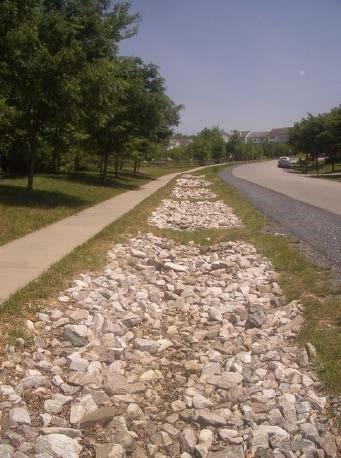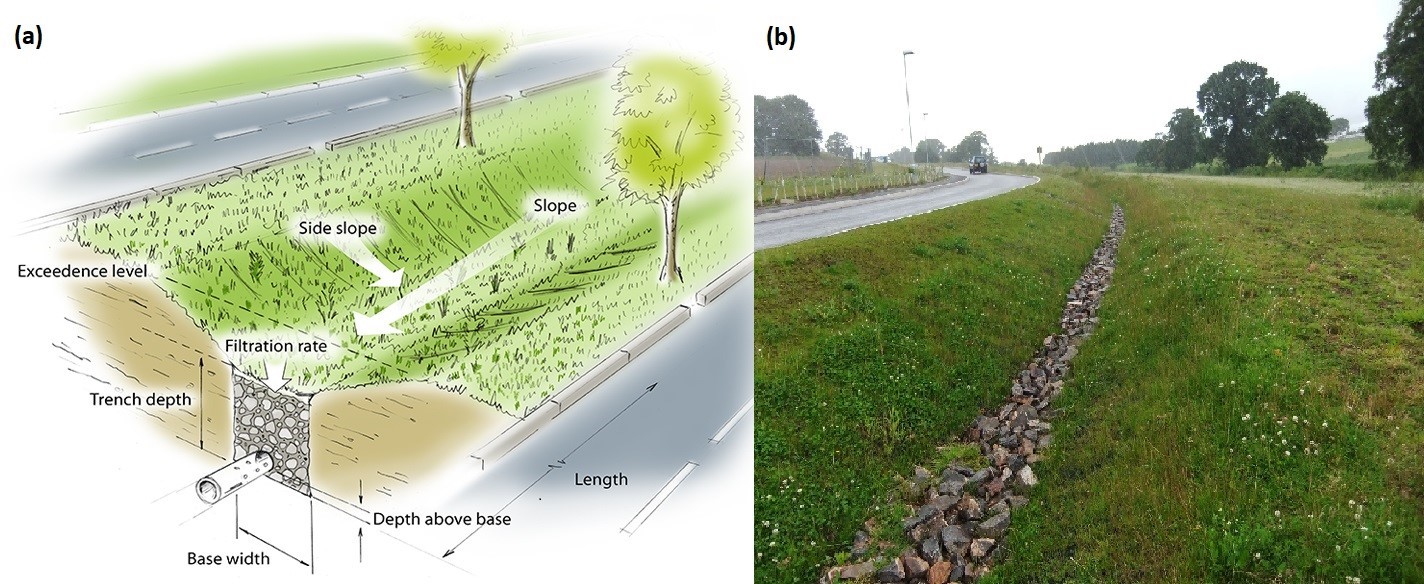Infiltration Trenches and Swales
Infiltration trenches
Infiltration trenches are shallow excavations filled with rubble or stone. They allow water to infiltrate into the surrounding soils from the bottom and sides of the trench, enhancing the natural ability of the soil to drain water. Infiltration trenches reduce runoff rates and volumes and can help replenish groundwater and preserve base flow in rivers. They are best located adjacent to impermeable surfaces such as car parks or roads/highways where there levels of particulates in the runoff are low. They work best as part of a larger sustainable drainage treatment train. Infiltration trenches are also ideal for use around playing fields, recreational areas or public open space. They can be effectively incorporated into the landscape and designed to require minimal land take.

Source: http://nwrm.eu/measure/infiltration-trenches
Impacts:
- Store Runoff → Medium
- Slow Runoff → Low (conclude that infiltration trenches are effective for runoff reduction for up to 1 in 30 year events (Blanc et al, 2012). The trench design must take in to account the infiltration rate of the underlying soil, to ensure effective operation. Blanc et al (2012) found in their review of literature that antecedent conditions can have a significant influence on performance. In addition, effectiveness can reduce significantly over time if high levels of sediment are allowed to enter the trench.)
- Increase infiltration and/or groundwater recharge → High(Infiltration trenches function by collecting runoff and infiltrating it to the underlying soils.)
- Increase soil water retention → Low (Infiltration trenches consist of a sub-surface structure with enhanced infiltration capacity and they could be considered to effectively increase soil water retention.)
- Reduce erosion and/or sediment delivery → Medium (They are effective in the removal of sediments where they are entrained in runoff in low concentrations, e.g. from roads. However high levels of sediment loading are likely to significantly reduce the performance of a trench over time, and require pre-treatment.)
Capital and maintenance costs:
- Capex → 70-90€/m3 stored volume
- Maintenance → 25-4.0€/m2 surface area
Swales
Swales are broad, shallow, linear vegetated channels which can store or convey surface water (reducing runoff rates and volumes) and remove pollutants. They can be used as conveyance features to pass the runoff to the next stage of the SuDS (Sustainable Urban Drainage System) treatment train and can be designed to promote infiltration where soil and groundwater conditions allow. Swales are applicable to a wide range of situations. They are typically located next to roads, where they replace conventional gullies and drainage pipe systems. Other examples can be located in landscaped areas, adjacent to car parks, alongside fields, and in other open spaces.

Source: (a) https://help.xpsolutions.com/display/XDH2016v1/Swale (b) https://www.salixrw.com/product/vmax3-p550-permanent-turf-reinforcementmat/attachment/7-vmax-p550-vegetated-swale/
This measure can contribute to water storage, climate change adaptation and mitigation, groundwater recharge, erosion/sediment control and flood risk reduction.
Impacts:
- Store Runoff → Medium(the capacity of a swale should be designed to attenuate and treat a rain event with a 10 – 30 year return period, although there is potential for runoff rate control up to a 1 in 100 year event (Blanc et al, 2012))
- Slow Runoff → High(The literature they reviewed showed significant variations in the runoff reduction achieved from swales, but in general more than 50% reduction in mean runoff)
- Increase evapotranspiration→ Low to Medium (it depends on the swale dimensions, residence time and type of vegetation)
- Increase infiltration and/or groundwater recharge → Medium(Infiltration increases where the residence time is higher, soil permeability is high and the infiltration surface is large.)
- Increase soil water retention → None to Low (Introduction of vegetation may over time increase the organic matter content and associated ability of the soil to retain water.)
- Reduce erosion → Medium (Sediment deposition is achieved through slowing runoff and the roughness of the vegetation)
- Reduce peak temperature → Low (Swales provide green areas and they can contribute to creating cool islands in urban landscapes)
- Absorb and/or retain CO2 → Low (If a swale is added where no vegetation would otherwise be present, this will result in a localized increase in uptake of CO2, particularly if woody vegetation is included)
Capital and maintenance costs:
- Capex → 15-80€/m2 swale area
- Maintenance → 5-4€/m2 swale area
Source: European Natural Water Retention Measures Platform, 2015 (http://nwrm.eu/measure/infiltration-trenches); European Natural Water Retention Measures Platform, 2015 (http://nwrm.eu/measure/swales)


